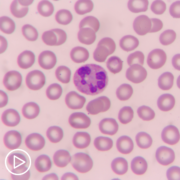What Healthcare Trends Are Observed in MPNs?
What Healthcare Trends Are Observed in MPNs? from Patient Empowerment Network on Vimeo.
MPN Empowerment Leads Jeff and Summer share trends they’ve observed since Summer’s initial diagnosis of myelofibrosis a few years ago. They share recent studies they’ve viewed and are following. Jeff gives a charge to viewers to be your own empowered patient and keep up with research when you can. “Be your own advocate.”
Videos Featuring Jeff and Summer:

|

|

|
Transcript:
Jeff:
Hi, I’m Jeff.
Summer:
And I’m Summer.
Jeff:
And we’re your Network Managers (Editor’s Note: Now referred to as Empowerment Leads) for Myeloproliferative Neoplasms for the Patient Empowerment Network. And, we’re here today to talk to you about healthcare trends in MPN medicine, basically.
Summer:
I was diagnosed with myelofibrosis over three years ago. And at the time, they could only offer me one medication, Jakafi (ruxolitinib), which for me work but doesn’t work for everybody. So, I’ve had good luck with it and I haven’t really had any other symptoms.
Jeff:
But this is an exciting time in the MPN medicine because since that time, there have been two more medications released to control myelofibrosis. One called fedratinib. And just last month, pacritinib was released and approved by the FDA. So now there are three medications that can be used to treat the symptoms of myelofibrosis.
There are currently no medications that can cure a person of myelofibrosis. The only cure, currently, is a stem-cell transplant. But some exciting developments are happening that may even be able to cure it.
I just read an article that some scientists have found that the medication used in breast care – breast cancer treatment causes remission in bone marrow fibrosis in mice. So they’re working along the way to see if that will be effective in humans, eventually. And that might be, potentially, a cure for myelofibrosis. Those are exciting trends in the MPN research and medicine world.
Summer has other information that’s useful though.
Summer:
Yeah, that’s really exciting about the new medication. I was looking up what the Mayo Clinical has to say and being happy and having a good attitude really enhances the immune system. There is a chemical that you get that comes from being happy that really, really keeps the disease from being more serious.
So anyway, that’s what I believe in because I’m an actor and so I don’t get into the medical thing, but I know Jeff is brilliant for it. So, that’s exciting all along having a good attitude and the new developments in medication.
Jeff:
So, keep those in mind, consult with your healthcare provider, and you need to be your own empowered patient and keep up with the research by yourself. It’s all available online, no problems at all, just Google it and you’ll be able to keep up yourself. You have to be your own advocate.
Until next time, I’m Jeff.
Summer:
I’m Summer and, wait a minute, this is our little baby, Zelda.


















